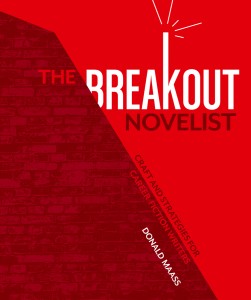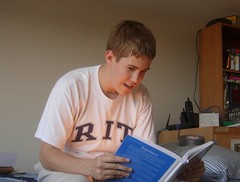by L. Jagi Lamplighter
My favorite book on how to write is Writing the Breakout Novel, by Donald Maass. Before encountering it, I was a non-believer. Writing books did nothing for me. Most seemed to be filled with an endless list of what not to do.
But something impelled me pick this book up . . . and everything changed!
Donald Maass is a top New York agent. He reads hundreds of manuscripts a year, maybe thousands. One day—perhaps dazed by the endless mountain of manuscripts he had to scale to reach his desk every day—he began thinking about the phenomena of the breakout novel.
 A breakout novel is not the same thing as a bestseller. A bestseller is a book that sells enough to make it onto the New York Times Bestseller’s list. A breakout novel is a novel that sells far more than anticipated. It might be a bestseller, or it might just be a book that was expected to sell five thousand that sold twenty thousand.
A breakout novel is not the same thing as a bestseller. A bestseller is a book that sells enough to make it onto the New York Times Bestseller’s list. A breakout novel is a novel that sells far more than anticipated. It might be a bestseller, or it might just be a book that was expected to sell five thousand that sold twenty thousand.
The significant thing about breakout novels, however, is that most of them do not get a lot of time or money put into promotion. Which makes sense. No one expected them to do well. But it means that their popularity came almost entirely from word of mouth.
And that is the ultimate compliment a book can have—that it sold well just because people who liked it told other people.
Maass’s question, as he looked nervously up at the tower of papers tottering over his desk, was this: Is the success of these breakout novels due to chance? Or were they actually better than other books?
So, he went out and bought himself one hundred recent breakout novels, and he read them.
And, guess what? They were better!
Which led him to another question: What made them better? What did these books have that so many of the manuscripts piled in the mountain looming over his desk lacked?
This search led to his book, Writing the Breakout Novel. Its success led to him teaching a workshop. He wrote up many of his exercises into a second book, the Writing the Breakout Novel Workbook. (He has since published a third related work called: The Fire in Fiction.)
In his work, Maass identifies what these books do that make them different: engrossing story, enchanting characters, enthralling pacing, enduring themes. Then, for each point, he shows how they do it. Giving examples and exercises that help the writer bring out similar strengths in their own work.
He identifies particular techniques for raising the stakes, for heightening emotions, for bringing characters to life. He also discusses the importance of them and identifies the two themes that resonate most with readers.
Reading his work entirely changed my fiction.
 Nearly all of Maass’s work is useful and insightful. Of all Maass’s exercises, however, my favorite is the one on page 64. (This is the villain’s version, but is just as useful for protagonists. I picked it because it is concise—having all the character exercises together in one place.) In it, he urges the writer to note the main quality and goal of their character. Then, to chose an opposite quality and goal. (I find that ‘contrasting’ or ‘opposing’ often works better than opposite.) Then, write a scene in which the character demonstrates the opposing quality or reveals the contrasting goal.
Nearly all of Maass’s work is useful and insightful. Of all Maass’s exercises, however, my favorite is the one on page 64. (This is the villain’s version, but is just as useful for protagonists. I picked it because it is concise—having all the character exercises together in one place.) In it, he urges the writer to note the main quality and goal of their character. Then, to chose an opposite quality and goal. (I find that ‘contrasting’ or ‘opposing’ often works better than opposite.) Then, write a scene in which the character demonstrates the opposing quality or reveals the contrasting goal.
This simple exercise can raise a character to a whole new level, catapulting one-dimensional characters into two-dimensions, and two-dimensional characters in to well-rounded three-dimensional ones.
How does this work?
In art, contrast and shading is what gives an object the appearance of three-dimensions. In writing, it is the same thing. Real life is a jumble of conflicts. We want to save money and buy that new vacuum. We want to move to the location of our dreams and stay near family. We want to admire our cake and eat it, too. These internal struggles are always with us, tormenting and compelling us.
When characters have similar struggles, we innately recognize it as like life, the same way that our eye is fooled by a little dark paint into believing that the shaded side of the bowl of fruit is farther away from us than the brighter side, because it reminds our eye of real shadows on real red glass bowls.
This is only one exercise of many that really brings one’s fiction alive. Another favorite is to take a moment and to pull it out of time, pausing to remind the reader how the past (last year, last month, ten minutes ago) is different from the present—how the character has changed in the intervening time. It is a wonderful trick for heightening the emotional impact of a scene and for drawing out the implications of your characters experience.
These examples are only two of many, many excellent points. His book can be used like a practical reference manual. Stuck? Not sure what your scene needs next? Open the Writing the Breakout Novel Workbook and flip through it until one of the techniques included leaps out at you, sweeping away your writer’s block.
So, as I mentioned, Writing the Breakout Novel is a book that helps the writer know what to do, instead of just what not to do. I found it so useful, I went and took his workshop in person, which was also very helpful.
Armed with Maass’s insights, I entirely revamped my novel and finally made the long-dreamed-of jump from the looming, teetering submission pile to the shelves of my local bookstore. You can, too!
About the author
L. Jagi Lamplighter is the author of the Prospero’s Daughter series, beginning with Prospero Lost. Her short stories have been featured in several science fiction, horror and fantasy anthologies. She also enjoys romance and anime. She blogs at Visions of Arhyalon.
 Then for Christmas, I asked for and received The Fire in Fiction on my Kindle, and Writing the Breakout Novel Workbook in paper. All of these books have challenged me as a writer, helping me to focus my stories better, deepen my characters, better ground my story in its setting, and more.
Then for Christmas, I asked for and received The Fire in Fiction on my Kindle, and Writing the Breakout Novel Workbook in paper. All of these books have challenged me as a writer, helping me to focus my stories better, deepen my characters, better ground my story in its setting, and more.






